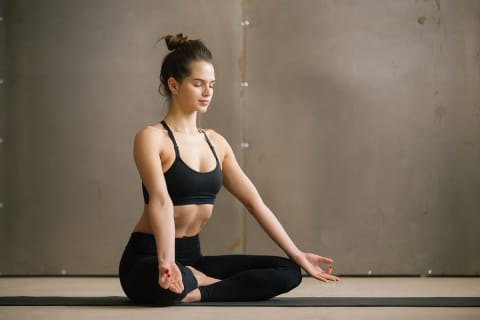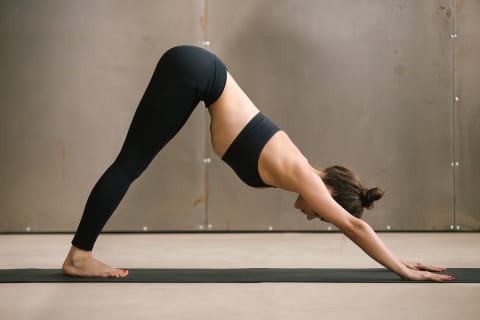A Simple Sleep Yoga Sequence To Prepare Your Body For Shut-Eye

This sequence of movements helps repair the relationship between your body, breath, and brain, allowing you to learn to listen to your body's needs. This sleep preparation practice can reduce physical tension, lower your heart rate, and decrease the stress hormones in your body. Doing them in your bedroom can make the room a calm and soothing space as you prepare for sleep.
This series of four movements, especially the basic yoga breath (more on that below), helps to relax the essential areas of your body needed to get to sleep. It only takes about 20 to 25 minutes when you're first learning it, and about 10 to 12 minutes when it becomes a routine, even if you're doing it slowly. And you'll find that it doesn't become less effective with continued use. Instead, the more you practice it, the better you'll become at getting a deeper and more releasing stretch!
Basic Yoga Breath

- Breathe in and out through your nose only (with your mouth closed).
- Intentionally create the sound you'd make when yawning or sighing by gently contracting/tightening the back of your throat to make a hissing sound. This lets less air through and streamlines the flow of your breath.
This tone in your throat, combined with lengthening your exhale, activates the "rest and digest" part of your nervous system (parasympathetic), creating more relaxation in your body and mind.
Cat Pose and Cow Pose

- Come up on all fours into a box position and spread your fingers out to open your hands.
- Keep your wrists under your shoulders (or just in front of them if your wrists feel tight) and your knees under your hips.
- Take a slow, deep breath in, arching your back and opening the front of your chest. This is cow pose.
- With a long steady exhale, draw your belly in and down, rounding the back and stretching between your shoulder blades. This is cat pose.
- Keep your eyes and forehead relaxed as you do this—you can even close your eyes if you prefer.
This pose stretches the muscles between your ribs, making space for you to breathe. It is also said to tone the vagus nerve, which runs from the back of your skull down into your torso, passing through all the major internal organs. It's responsible for body-to-brain messaging between your heart and other internal organs, which signals whether your body is relaxed or agitated. This set of slow movements sends the relaxation message.
Slow breathing and rhythmic movement done together calm and soothe your nervous system. Keep the Basic Yoga Breath throughout the sequence, and when you find you've forgotten to breathe like this, just start again.
Downward Dog

- Move from all fours into an inverted V shape by lifting your knees off the floor and walking your feet back behind your pelvis.
- Press your hips upward and back so that your bottom forms the angle of the inverted V, pressing your chest back toward your legs.
- Keep your arms straight and fingers spread evenly.
- Relax your neck: Keep the back of your neck long.
This pose reestablishes good circulation and stretches in the longest body muscles: hamstrings, shoulders, spinal support muscles, and neck. Placing your head below your heart calms your mind, and being inverted (upside down) brings circulation to your chest—and with plenty of oxygen, your body feels more balanced and refreshed.
Child's Pose

- From a box position, bring your big toes together and widen your knees apart.
- Bring your bottom down toward your heels. If this is too much strain on your hips, roll up a blanket and place it beneath your bottom. Let your arms rest by your sides.
- With your forehead on the floor, press the flesh of your forehead downward toward your nose—this releases the frontalis muscle in your forehead, which feeds back a calm signal to your nervous system.
- Breathe here: Visualize your breath moving up the back of your body as you inhale and down the front as you exhale. Stay here for 5 to 10 breaths, or longer if you wish.
This pose can be used on its own or after downward dog, after which you slowly lower your knees to the floor. This pose lengthens your back muscles and the back of your pelvis and can feel very calming and soothing. It's a pose that many young children discover on their own as a way to re-center when they feel overwhelmed.
Adapted from Sleep Recovery by Lisa Sanfilippo. Reprinted with permission from Bloomsbury Publishing, 2020.

Lisa Sanfilippo, M.S., RYT is a registered yoga teacher and psychotherapist, and she writes books and offers training for yoga teachers and wellbeing professionals. She is the pioneer of Sleep Recovery, a yoga based method for overcoming insomnia and improving sleep. Her aim is to offer those she works with access to deeper levels of awareness and the means of finding a deepening connection to body and mind, heart and soul.Her yoga classes draw upon bio-mechanical alignment principles, Tantric philosophy, art, and psychology.
Lisa's practiced yoga since 1997 and taught since 2002. She seeks to challenge and refresh you on all levels with yoga postures, breath work, meditation and sound. She became a dedicated yoga practitioner in 1997, after graduating Brown University and moving to New York and began teaching yoga to students at the LSE in 2002, where she was completing her first Master’s degree. Soon after, she was invited to teach at Triyoga and the Life Center, where she has remained for many years.
